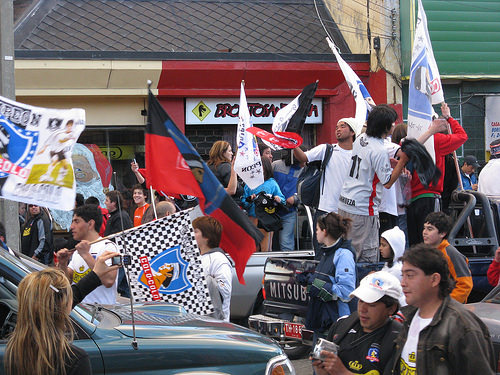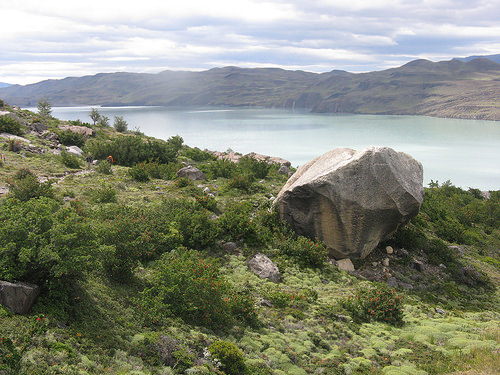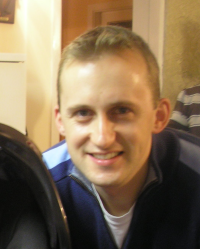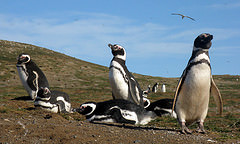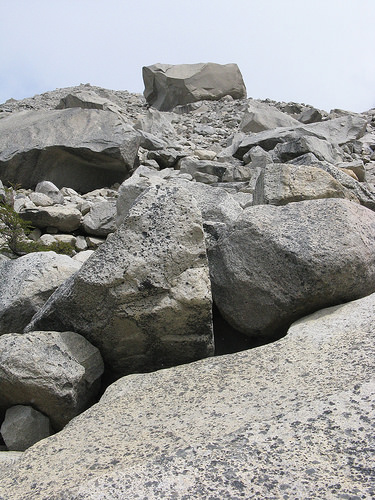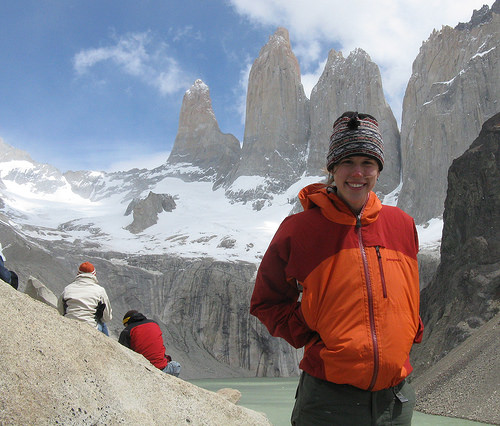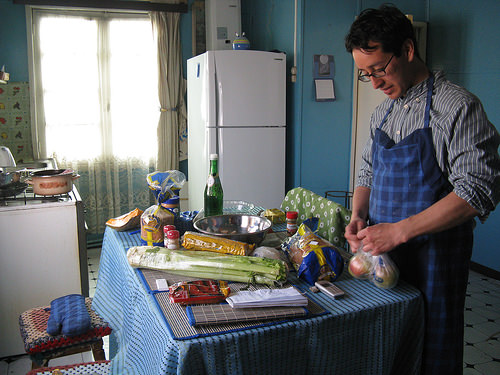The steady thwop-thwop-thwop of a helicopter passing over my cabin woke me up this morning. More than a month after 28-year-old Irish hiker Ronan Lawlor went missing, his body was discovered by Brazilian tourists near the base of the towers yesterday. A search and rescue group is ascending to the spot this morning to fly out his remains.
¿Hasta cuaaaando ya?: A lesson in Chilean slang
When I arrived in Chile three months ago, people’s stories were a lot wilder than they are now. One day at lunch, for example, I learned there’s a two-week period every August where Venezuelans take to the street and eat banana Jello, and I considered making a trip. As I've grown more accustomed to the language, the stories have calmed down a bit and have started to make more sense. But to understand them completely, it helps to recognize the slang that peppers most every Chilean sentence.
Here’s a quick guide to the Chilean slang I’ve picked up on so far: Al tiro — Immediately Bacán — Cool! ¿Cachai? — Get it? Carrete — Party Fome — Boring Guagua — Baby Guata — Belly Huevón(a) — Buddy, Dude, Man, Jerk or Asshole, depending on the context. Often added to the end of a sentence to indicate familiarity. La onda — Attitude, mood, character of person. As in “Ella es buena onda” or “She’s got a good vibe.” La pega — Work, Job Pololo(a) — Boyfriend/Girlfriend Po — Well Short for “pues.” Added onto the end of many sentences and phrases. As in “Sí po” or “No po.” Ponte las pilas — Go for it! Try harder! Literally “Put your batteries in.” La raja — Excellent, Cool, The shit El tuto — Sleepiness (in a cute sense) As in “Tengo tuto” or “I’m sleepy,” and “Voy a hacer tuto” or “I’m going to take a nap.” Wea — That shit As in “Esa wea no funciona” or “That shit doesn’t work,” and “Esa wea está mala” or “That shit is bad.”
A separate slang culture, mainly driven by the baqueanos (Chilean cowboys), has developed within the park. Here a few phrases you need to get around here: Meh — A sound used to express surprise or disbelief Vamos, VAAAAH-mos — Let’s go, leeeeet’s go. Shouted as loud as possible, often by a baqueano, a guide or me, when prodded ¿Hasta cuaaaando, yaaaa? — When’s it gonna stop? Literally, “Until when, already?” Uttered with a nasally voice in fake annoyance
There you have it. Consider yourself Chilean.
Fútbol is life
As I walked from my hostel toward the center of Punta Arenas the other afternoon, I heard the announcer on someone’s television scream “Gooooooooooooooooooooooooool” from an open window.Minutes later, everyone in town rushed to Calle Bories, a main drag that’s always pumping with eaters, shoppers and vendors selling strawberries, garlic or handmade bracelets. Most of the congregants on that day were wearing shiny polyester soccer jerseys. They circled the block in cars, honking their horns. They hung from windows, ran through the streets waving oversized flags, slapped each other on the back, yelled.
About 15 minutes into the commotion, I entered the Abu Gosch supermarket. When I emerged 45 minutes later with a bag of vegetables and some cheese, the noise and excitement were strong as ever. Here’s the story, as told by the man in front of me in line at the grocery store: The Colo-Colo soccer team won. They were playing another team. There are many soccer teams in Chile. Colo-Colo is one of them. Here’s the same story, told with slightly more flair by a man I met on the sidewalk on the way back to my hostel: The Colo-Colo soccer team beat the University of Conception 2-0 in the national championship. The Colo-Colo team is based outside of Santiago, but since Punta Arenas does not have a soccer team of its own, most here root for Colo-Colo, a team that has come to stand for the working class. The team will go on to play other countries.
So, there you have it. Colo-Colo is one of many teams in Chile. But it’s one worth keeping an eye on.
Walkin' the W
Trying to put up a tent in the wind is like trying to walk a big, dumb animal that has an agenda distinctly different from your own. On the first night of my 3.5-day solo-hiking excursion along the Torres del Paine’s legendary W Circuit, my tent wanted to go in the thorny bushes surrounding the campsite — or the lake, it didn’t matter — and I wanted it to go in the nice, flat spot I had picked out in Paine Grande campground.I’m proud to report that after a long, fierce battle, I firmly anchored my opponent to the earth with titanium stakes, and I lined its inside with heavy rocks for extra measure.
Triumph
The W Circuit is approximately 50-kilometer route through Torres del Paine National Park that runs between Grey Glacier the granite towers themselves, ascending the awe-inspiring Valle Frances along the way (forming, oddly enough, a W-shaped route).
A mystic mountain and wind-blown lenga tree I encountered along the trail
For some reason, I wasn’t intimidated by the prospect of taking on the W alone (I didn’t find out about the disappearance of Irish hiker Ronan Lawlor until after I returned). I figured the trails were well marked and I was way more likely to run across a crazy psycho maniac in the hollers of North Carolina than the internationally-visited Torres del Paine. Still, I packed a map and first aid kit, gave Victor in the office my route and asked him to send out a search party if I wasn’t back by Tuesday. I started the hike toward Glacier Grey along the western leg of the W in rain and the 90-km-per-hour winds on Friday morning. The trail ascends a valley, passes the dark-watered Laguna Los Patos and then traces the shoreline of Lago Grey as it approaches the 15-mile-long glacier, one of the largest tongues of the Southern Patagonia Ice Field.
Icebergs in Lago Grey
The still, blue glacier fills the valley it occupies almost to the top, and its edge hugs an island as it meets Lago Grey. The ice field is hard for the eye to comprehend from afar because the sun refracts off it in so many different directions. It registers as a white glow that’s hard to distinguish from the sky. When I crested a hill and first glimpsed it, I inadvertantly gasped and got chills at the same time.
Glaciar Grey and its island
The wind blowing off the glacier is fierce and unrelenting. Despite the rough conditions, though, flowers manage to bloom. I’m impressed by their resiliance.
On Day Numero Dos, I hiked about two hours from the Paine Grande campground to Valle Frances. I pitched my tent at the base of the valley in Campamento Italiano, reserving a spot in the lenga forest right by the river. Then I strapped on a fanny pack (yes, a fanny pack) and ascended the valley, the looming, glacier-ridden Cuerno Paine Grande to my left and the smooth, granite slabs of Los Cuernos to my right.
Los Cuernos from the trail
Let me just say, the view from the mirador at the top of the valley is one of the best in the park: Towering rock formations, including Las Torres in the distance and Los Cuernos more immediately, surround you on all sides. Lucky for me, the ranger who works the Italiano campsite invited another camper and me into his metal-sided shack for dinner. We pooled our pack food, fed the wood-burning stove and created a rich feast of 5-Minute Rice, pasta with red sauce and sauteed hot dogs. As the water boiled, we listened to traditional Chilean music on a set of just-repaired speakers and discussed beehives and garbage. The social interaction was good.
The following day, a warm bed and fluffy comforter thwarted my well-laid plans. I had intended to hike to Refugio Los Cuernos and convince one of the staff members to explore the hidden Valle Bader with me in hopes of touching the base of Los Cuernos themselves and glimpsing the elusive huemul (an endangered deer said to live in the valley). But when the Refugio Cuernos staff offered me a free stay in one of the cozy, A-frame cabins on a hillside overlooking Lake Nordenskjold, I accidentally spent all afternoon napping and reading Jon Krakauer’s “Into the Wild.” It was heaven, really. I helped the Cuernos staff wash dishes in the refugio as a thank-you.
My cabin
After breakfast in the refugio the following morning, I strapped on my pack, extended my hiking poles and took off toward Refugio Las Torres, my home base. The sun was shining, the birdies were chirping and Lago Nordenskjold was blue as ever.
I stepped off of the trail and onto my doorstep, feeling exhilerated by three days in the aire libre of Paine.
Visit this link to see more pics from the hike.
Missing person
Ronan Lawlor started the W Circuit in Torres del Paine on Nov. 18 and has not been seen since. The 28-year-old chemical engineer from Ireland signed in when he entered the park, but never signed out. He has not contacted his family in over a month and has yet to return to a hostel in El Calafate, Argentina where he left his rucksack. The Irish embassy, local police and park rangers began an official search for Ronan today. If you have any information on his whereabouts, email inforonan@gmail.com.
Ronan Lawlor
Penguins are funny
Everyone on Chile’s Isla Magdalena looks just about the same. Black is in, white is in, and horizontal stripes are considered OK. The treeless, grassy island, located in the Strait of Magellan off the coast of Punta Arenas, is home to about 150,000 Magellanic penguins for a few months every year.

I spent a recent afternoon wandering the island, coming within several feet of many of its inhabitants, who seemed to carry on with their usual activities despite my presence. These consisted mainly of:
1. Grooming (very important)
2. Sitting/lying (secondarily important)
3. Walking in lines (a third priority)
And now, for some fun Magellanic penguin facts: • Magellanic penguins eat the cuttlefish, sardines, squid, krill and other crustaceans they find in the water. They rely on a salt-excreting gland to filter the salt out of their food. They do without pepper as well. • The species of penguin gathers in large colonies off the coast of Chile and Argentina every summer to nest and breed. The men arrive early and await their women, who manage to recognize them by call alone (and perhaps, too, by that special twinkle). • The penguin couples lay two eggs at a time and usually end up raising one or both to adulthood. Parents take 10- to 15- day shifts watching over their eggs during the almost two-month incubation period. After the babies are born, the proud mother and father feed them every two to three days. • Magallenic penguins live an average of 25 years in the wild. • They have been assigned a “near threatened” status, though millions live off the coast of Chile, Argenitina and Brazil. Oil spills, declining fish populations and the hungry mouths of predators like sea lions and giant petrels have made breeding extra important.
To get to Isla Magdalena, you sign up with a tour agency in Punta Arenas, lay down $64, catch a 7 a.m. or 5 p.m. shuttle to the “Tres Puentes” port outside the city and ride a zodiac 35 minutes across the strait. Once you reach your destination, you’re set free for a couple hours to stroll the path that circles the island.
On the way home from the colony, we made a pit stop at Isla Marta, home to about 1,000 sea lions that visit their neighboring island every day around lunch time. Our guide explained that the lions were lying on the beach in three basic piles: males, females and rejects. It reminded me of middle school.
An ode to my gloves
It might be a sunny 60 degrees while you’re packing for your hike through Torres del Paine National Park. But don’t be fooled. You need your gloves. The weather is unpredictable and often rotates through the four seasons in one day. It might be sunny when you wake up, raining by mid-day, snowing by 3 and sunny/blue again by dinner.
I learned this lesson the other day when temperatures plummeted midway through my ascent to the towers. As the weather worsened, my hands went numb, and tasks I usually complete without a thought suddenly occupied me for a longer than I’d like to admit.
Among the most daunting of my challenges were:
1. Opening the wrapper of a granola bar 2. Zipping up my rain jacket 3. Pushing the ‘take a picture’ button on my camera 4. Tearing duct tape off the roll to stick over the hot spot on a hiking partners’ heel 5. Unclipping the waist belt of my daypack 6. Unsnapping and unzipping my pants’ fly / re-snapping and re-zipping my pants’ fly (It’s especially embarrassing if you manage to accomplish the former, but not the latter.)
A moraine made slightly less impressive by freezing hands
For those of you heading out for a day in the park, I recommend you wear a synthetic outfit and broken-in boots and pack the following items, even if you don’t think you’ll need them:
Warm gloves Warm hat A fleece or wool pullover Rain jacket Sun hat Sunglasses Sunscreen More than 1 liter of water A snack A first aid kit
Despite my trials, I made it to the towers the other day. Here they are and here I am:
I would like to thank this statue for allowing me to be here
 I owe the chance to live and work in Chile to the foot on this statue. I touched it three years ago when I was here, and guess what? I’m back.
According to legend, travelers that touch — or kiss — the toe of the Ona man on the statue in Punta Arenas’ central plaza will someday return to Patagonia. The statue was commissioned by wool baron José Menéndez in 1920 to commemorate the 400th anniversary of Portuguese navigator Hernando de Magallanes’ discovery of the Strait of Magellan.
I owe the chance to live and work in Chile to the foot on this statue. I touched it three years ago when I was here, and guess what? I’m back.
According to legend, travelers that touch — or kiss — the toe of the Ona man on the statue in Punta Arenas’ central plaza will someday return to Patagonia. The statue was commissioned by wool baron José Menéndez in 1920 to commemorate the 400th anniversary of Portuguese navigator Hernando de Magallanes’ discovery of the Strait of Magellan.
I touched the toe again last Saturday, which means… maybe I should open a bank account here.
Thanksgiving in Patagonia
Cranberries are next to impossible to find in Patagonia. Gabriel and I hunted/gathered at three separate grocery stores on Thanksgiving and finally had to give up on the idea of cranberry sauce to accompany our turkey parts (turkey, too, is difficult to find). But we did manage an otherwise delicious feast to celebrate the day the Pilgrims and the Indians sat down together at a table and shared a bursting cornucopia, despite their differing hat preferences (square buckle/feathers).
It was comforting to celebrate ye old American holiday all the way down here in Patagonia, to eat semi-accurate renditions of the dishes my mom puts on the table back in North Carolina. We whipped up the feast in the kitchen of Gabriel’s apartment and partook of it with Gabriel’s girlfriend Gloria, who was born and raised in Chile but more than willing to help us celebrate the all-American holiday.
Gabriel preparing to peel apples for the stuffing
Here’s what was on the menu: • Turkey parts (with, ummm, butter, salt, rosemary and whatever else I found in Gabriel’s cabinet. Failed to look that one up on epicurean.com beforehand.) • Sausage, apple and cranberry stuffing (minus the cranberries, sage and cooked turkey liver, which Abu Gosch grocery does not carry). This was the definite highlight of the meal for me, which is why I had 2-3 servings. • Cornbread, with tiny bits of green pepper baked inside • Carrots, cucumber and celery salad • Instant mashed potatoes, remembered last minute, purchased at the corner store across the street 10 minutes before the plates hit the table. As we clinked glasses of sparkling apple cider, we took a minute to give thanks for what we have. For me, that includes the chance to be in a place that doesn’t have cranberries, whole turkeys and the other trappings of a culture I already know.
Go ahead, take a sip. Everybody's doing it.
I’ve heard enough horror stories to reject any water taken straight from the creek. I’ve had friends incapacitated for days on end by the giardia bug that rejects, projectile-style, any food or drink that dares enter the body. ‘Purify, purify, purify’ has been pounded into my head during so many backpacking trips and outdoor leadership training sessions that I can fix a broken water filter with my eyes closed. That’s why, when a friend assured me on a hike that Paine water is safe from it’s source, my first reaction was ‘Whaaa? No way! That goes against everything I stand for!’
But, as I stood in front of a mountain waterfall sipping a Nalgene of water taken from the bathroom sink at work, I grew tempted by the clear, cool H2O flowing by my feet.
Then, I did something unthinkable. I poured out my carefully chlorinated sink water, submersed my bottle in the creek until no more bubbles rose to the surface — and, without taking any precautions whatsoever, took several long, deep gulps.
After that, I waited. I waited through the afternoon and evening and into the next three weeks for some sign that what I had done was a really, really bad idea. But a sign never came.
My conclusion: Paine water really is safe to drink from its source. And, it’s damn delicious.
All quiet on the Southern front
A 7.7-magnitude earthquake rattled the desert 780 miles north of Santiago yesterday morning, but we felt nothing down south in Torres del Paine. While the plates shifted under Chile’s second region, injuring hundreds and killing at least two, they remained really quite still under its twelfth. Oblivious to the news, the people in Paine appreciated blue skies behind the often-clouded rock towers and thought to themselves, ‘I wish those damn gulls would quit their squawking.’ Now, as Navy seals unearth the laborers trapped in a collapsed highway tunnel and relief workers hand out food to those left homeless by the quake, the people of Paine check the news, but strap on their boots and hit the trails anyway.

The advent of the bicycle in Torres del Paine
Las Torres hotel took a bold first step in creating a mountain biking program: they bought the bikes. Two guides and I agreed to sample the merchandise for company photographer Gabriel Ortega, who needed some pictures for marketing material we’ll put out soon. We three did our best to look like bad asses as we rolled over the trail toward Laguna Inge and Los Cuernos: We took downhills extra fast and splashed extra big as we rode through streams that crossed the trail.

Though the hotel has not yet decided which routes it will open to the bikes, the terrain we rode that day was ideal for biking: smooth, fast and in the shadow of some incredible snow-capped mountains. Give me a bicycle, and I'll sample it anytime.
Photo by Gabriel Ortega

